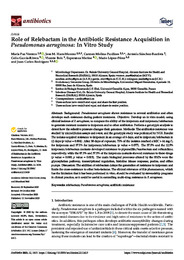Please use this identifier to cite or link to this item:
https://hdl.handle.net/11000/35462Full metadata record
| DC Field | Value | Language |
|---|---|---|
| dc.contributor.author | Ventero, Maria Paz | - |
| dc.contributor.author | Haro-Moreno, Jose M. | - |
| dc.contributor.author | Molina-Pardines, Carmen | - |
| dc.contributor.author | Sánchez Bautista, Antonia | - |
| dc.contributor.author | García Rivera, Celia | - |
| dc.contributor.author | Boix, Vicente | - |
| dc.contributor.author | Merino de Lucas, Esperanza | - |
| dc.contributor.author | López-Pérez, Mario | - |
| dc.contributor.author | RODRIGUEZ DIAZ, JUAN CARLOS | - |
| dc.contributor.other | Departamentos de la UMH::Producción Vegetal y Microbiología | es_ES |
| dc.date.accessioned | 2025-01-29T10:20:34Z | - |
| dc.date.available | 2025-01-29T10:20:34Z | - |
| dc.date.created | 2023-11-11 | - |
| dc.identifier.citation | Antibiotics (Basel). 2023 Nov 11;12(11):1619 | es_ES |
| dc.identifier.issn | 2079-6382 | - |
| dc.identifier.uri | https://hdl.handle.net/11000/35462 | - |
| dc.description.abstract | Background: Pseudomonas aeruginosa shows resistance to several antibiotics and often develops such resistance during patient treatment. Objective: Develop an in vitro model, using clinical isolates of P. aeruginosa, to compare the ability of the imipenem and imipenem/relebactam to generate resistant mutants to imipenem and to other antibiotics. Perform a genotypic analysis to detect how the selective pressure changes their genomes. Methods: The antibiotics resistance was studied by microdilution assays and e-test, and the genotypic study was performed by NGS. Results: The isolates acquired resistance to imipenem in an average of 6 days, and to imipenem/relebactam in 12 days (p value = 0.004). After 30 days of exposure, 75% of the isolates reached a MIC > 64 mg/L for imipenem and 37.5% for imipenem/relebactam (p value = 0.077). The 37.5% and the 12.5% imipenem/relebactam mutants developed resistance to piperacillin/tazobactam and ceftazidime, respectively, while the 87.5% and 37.5% of the imipenem mutants showed resistance to these drugs (p value = 0.003, p value = 0.015). The main biological processes altered by the SNPs were the glycosylation pathway, transcriptional regulation, histidine kinase response, porins, and efflux pumps. Discussion: The addition of relebactam delays the generation of resistance to imipenem and limits the cross-resistance to other beta-lactams. The clinical relevance of this phenomenon, which has the limitation that it has been performed in vitro, should be evaluated by stewardship programs in clinical practice, as it could be useful in controlling multi-drug resistance in P. aeruginosa | es_ES |
| dc.format | application/pdf | es_ES |
| dc.format.extent | 12 | es_ES |
| dc.language.iso | eng | es_ES |
| dc.publisher | MDPI | es_ES |
| dc.rights | info:eu-repo/semantics/openAccess | es_ES |
| dc.rights | Attribution-NonCommercial-NoDerivatives 4.0 Internacional | * |
| dc.rights.uri | http://creativecommons.org/licenses/by-nc-nd/4.0/ | * |
| dc.subject | Relebactam | es_ES |
| dc.subject | Pseudomonas aeruginosa | es_ES |
| dc.subject | Antibiotic resistance | es_ES |
| dc.title | Role of Relebactam in the Antibiotic Resistance Acquisition in Pseudomonas aeruginosa: In Vitro Study | es_ES |
| dc.type | info:eu-repo/semantics/article | es_ES |
| dc.relation.publisherversion | https://doi.org/10.3390/ antibiotics12111619 | es_ES |

View/Open:
Role of Relebactam in the Antibiotic Resistance Acquisition.pdf
1,01 MB
Adobe PDF
Share:
.png)
